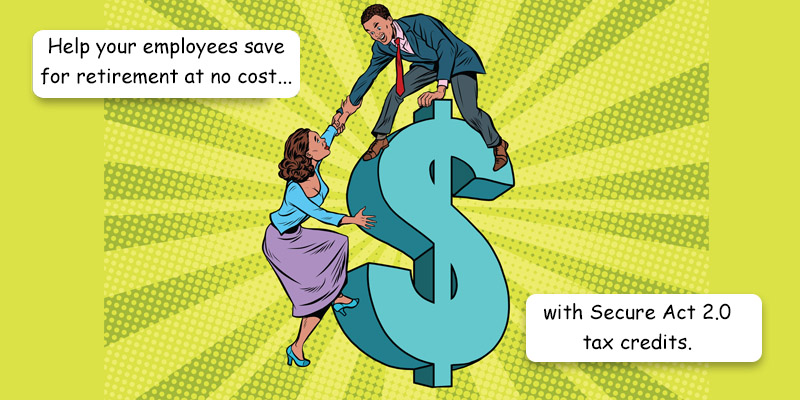They say timing is everything, and if there were ever a time to implement a 401(k) plan, the time is now. We first wrote about the Secure Act 2.0, in this post back in February 2023, a short time after it was signed into law by President Biden. One of the best parts of this act is that the government wants to give business owners money to start a plan AND even better, they want to give you money to give to your employees.
This is accomplished in three different tax credits to small business owners, as covered below. Let’s see how a business owner with just 15 employees can receive $65,250, over the course of 5 years, for implementing a new plan:
New Plan Startup Costs
Employers with 1 to 50 employees, implementing a new plan, are eligible for $250 per non-highly compensated employee (HCE), up to $5,000 (minimum $500.) Employers with 51 to 100 employees are eligible for 50% of the above costs. The credit is to offset plan operating, implementation and administration costs and is available each year for the first three years of the plan.
To be eligible, employers must meet the following requirements:
- Have 100 or fewer employees who were paid at least $5,000 in compensation by you in the preceding year
- Cover at least one non-HCE* with your retirement plan
- In the three tax years before the first year you’re eligible for the credit, your employees weren’t, substantially, the same employees who received contributions or accrued benefits in another retirement plan sponsored by you, a member of a controlled group that includes you or a predecessor of either.
- A business cannot take advantage of this tax credit by adding a 401(k) feature to an existing profit sharing plan. A business would also not be able to terminate an existing 401(k) plan and adopt a new 401(k) to receive this tax credit.
*An HCE is one that owns more than 5% of the business, no matter what their compensation is, or an individual that received more than $150,000 in the preceding year (2023).
Automatic Enrollment
Plans established after December 29, 2022 will be required to add employee automatic enrollment by 2025. Implementing the automatic enrollment, upon startup, will generate a $500 credit to the employer each year, for the first three years of the plan.
Only one requirement for this credit:
- Employers must have 100 or less employees. Count is based on the number of employees who made at least $5,000 in the preceding year.
Employer Contributions
The best part of this credit is the government giving you free money to give to your employees! A business with 50 or fewer employees will receive a tax credit for 100% of employer contributions in the first two years (including the startup year), 75% of employer contributions in the third year, 50% in the fourth year, and 25% in the fifth year. Employers with over 50 employees, the credit is reduced by 2% for each employee over 50 earning less than 100,000 per year. The credit is phased out for employers with over 100 employees.
The maximum limit is $1,000 per eligible employee per year. An eligible employee is paid no more than $100,000 a year, which will be adjusted for inflation each year.
Summary
With those three credits, an employer with 15 non-HCE employees will receive $3,750 ($250 x 15 employees) in new plan start-up costs each year, for three years. Adding on automatic enrollment to the plan will result in an additional $500 for each of those three years. Assuming each employee will defer enough compensation into the plan to reach an employer contribution of $1,000, the resulting credit will be $15,000 in the first and second year of the plan ($1,000 x 15 employees), $11,250 in the third year, $7,500 in the fourth year and $3,750 in the fifth year.
And just like that, the business receives $65,250 over the course of 5 years. The credit is claimed on IRS Form 8881, filed with the business tax return.
While we make every attempt to ensure the accuracy and reliability of the information provided in this document, the information is provided “as-is” without warranty of any kind. Romeo Chicco or PayMaster, Inc does not accept any responsibility or liability for the accuracy, content, completeness, legality, or reliability of the information contained. Consult with your CPA, Attorney, and/or Financial Advisor.

